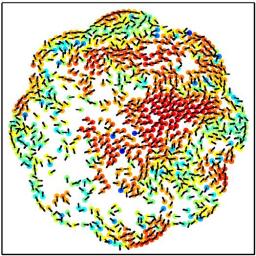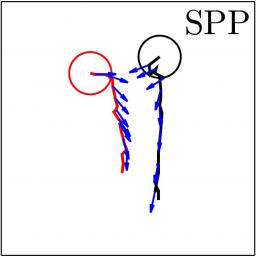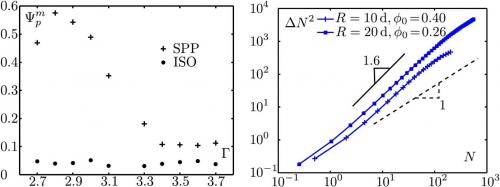
Collective motion of self-propelled particles for an area fraction φ = 0.47 and a vibration amplitude Γ = 2.7g. The red color reveals a perfect local alignment between particles whereas the blue color codes a perfect local anti-alignment.
and Olivier Dauchot, researchers in the Group of Instabilities and Turbulence at IRAMIS-SPEC have revealed experimentally the spontaneous onset of collective motion in a system of vibrated self-propelled circular disks. The emergence of such an order is remarkable because it should only exist in a system made of intrinsically out-of-equilibrium components. In the present study, the order persists despite the interactions being rather unfavorable.
For fifteen years, physicists have been wondering if "universal aspects" can be identified among the collective motions observed in nature such as flocks of starlings, colonies of bacteria or herds of sheep. These phenomena can be described by a common physical concept based on a new kind of condensed matter; namely, the polar active matter. It is defined as a system of macroscopic particles that dissipate the input energy and move along their own directions. Several theoretical models have reported the existence of a dynamical phase transition toward a polar order in 2D agent-based systems. However, the rules of interactions in these models are specific: the polar order exists only for the rule of ferromagnetic alignement; i.e., as soon as two self-propelled particles interact, their velocities align each other. Are these models robust in an experiment of a system of self-propelled particles that interact each other in a more complicated way?
We have set up a 2D system of asymmetric disks, self-propelled thanks to vibration, that interact only by contact. They behave as random walkers with a persistence length of the trajectories greater than the size of the disks. The greater the amplitude of vibration is, shorter the persistence length is. The alignment rules resulting from the coupling between the persistence of the motion and the hard-core repulsion between the particles are complex. For instance, we observe that only 10% of collisions lead to an effective ferromagnetic alignement. We observe also a transition toward collective motion when the amplitude of vibration is decreased, i.e. when the persistence length increases. The measurement of giant density fluctuations reveals the existence of an intrinsically out-of-equilibrium polar order in our experiment.
Combined, these results show the first experimental observation of the phase transition previously described in the models for 2D polar active matter. It also suggests that defining of a universality class for such systems is possible.
This work was featured on the cover of the August 2010 issue of Physical Review Letters 105 135702 (2010).













 Institut Rayonnement Matière de Saclay
Institut Rayonnement Matière de Saclay